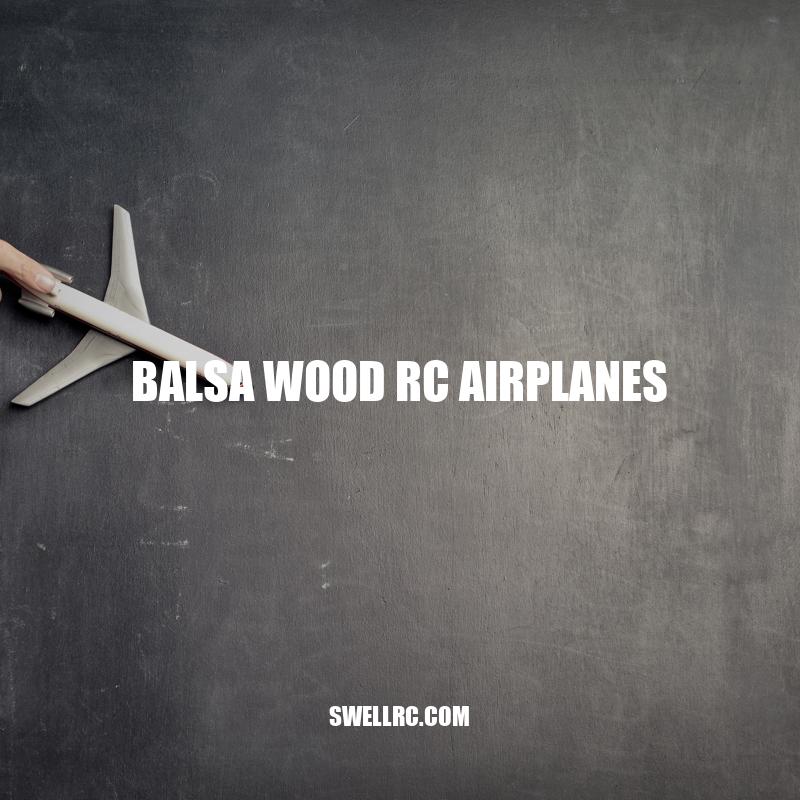Exploring Balsa Wood RC Airplanes: Benefits, Building, Flying, and Maintenance
Balsa wood RC airplanes have been a beloved hobby for aviation enthusiasts for decades. The lightweight and durable properties of balsa wood make it an ideal material for model aircraft. With its combination of strength and flexibility, balsa wood can be used to create detailed and intricate designs, from small gliders to complex remote-controlled planes. Building and flying balsa wood RC airplanes is a hobby that requires patience, skill, and attention to detail. It offers enthusiasts a satisfying and rewarding experience, allowing them to bring their own designs to life, test their piloting skills, and take part in competitions with like-minded hobbyists. In this article, we’ll dive into the benefits of balsa wood RC airplanes, the steps required to build and fly them, and how to maintain them for optimal performance. Whether you’re a seasoned builder or an eager beginner, this guide will provide you with the knowledge and resources you need to create your own balsa wood RC airplane and take to the skies.
Balsa wood is a popular material for RC airplanes due to its numerous benefits, including:
– Lightweight: Balsa wood is extremely lightweight, which means it requires less power to fly, making it ideal for models that rely on battery power and remote control.
– Durable: Despite its lightweight nature, balsa wood is also remarkably strong, which means it can withstand the stress and pressure of being flown at high speeds or in rough weather conditions.
– Customizable: Balsa wood can be easily shaped and sanded to create custom designs and details that other materials might not allow, making it ideal for those who want to create truly unique airplanes.
– Good quality-price ratio: Balsa wood is an affordable material for RC airplanes, making it accessible for hobbyists on a budget.
For those interested in exploring the world of balsa wood RC airplanes, there are various online communities and resources available to help. Websites like Flite Test and RCGroups offer a wealth of articles, videos, and forums with tutorials, tips, and tricks for building and flying RC airplanes made of balsa wood. Additionally, online retailers like Great Planes sell balsa wood airplane kits that include everything needed to build a complete model airplane from start to finish.
Why balsa wood is used for RC plane?
Balsa wood is used for RC planes due to its exceptional strength-to-weight ratio, which makes it a perfect material to construct durable models that can fly in a realistic manner. This is the reason why balsa wood has been considered the standard material for model airplane construction since the late 1920s. If you’re looking to build an RC plane, websites like towerhobbies.com and motionrc.com offer a wide selection of balsa wood kits and materials.
Building Balsa Wood RC Airplanes
Building balsa wood RC airplanes is a rewarding and enjoyable process. Here are the basic steps to get started:
- Choose a design: Decide on the design and size of the airplane that you want to build. RC airplane kits are available for purchase online, or you can create your own design using plans and templates found online.
- Prepare the materials: Purchase the necessary balsa wood, hobby knife, sandpaper, and glue to bring your design to life.
- Cutting and Sanding: Using a hobby knife, cut the wood pieces according to the design and templates. Sand the pieces down to smooth any rough edges and shape them into the desired form.
- Assembling the Parts: Use glue to assemble the different parts of the airplane, such as the fuselage, wings, tail, and landing gear, together.
- Painting and Decorating: Once the glue has dried, paint and decorate the airplane using the desired colors and designs.
- Testing and Adjusting: Test the airplane’s flight capabilities and make any necessary adjustments to the design or parts before flying it.
Interesting facts:
– Balsa wood is native to Central and South America and has been used for centuries for various purposes, including making rafts, boats, and even furniture!
– Balsa wood is one of the fastest-growing trees in the world, growing up to 4 meters in just one year!
To make the building process easier, various online communities and resources offer tutorials, tips, and tricks for building and flying RC airplanes made of balsa wood. Websites like Flite Test and RCGroups are great places to start. They offer detailed step-by-step tutorials and even include forums where people can share their experiences, ask questions, and get advice from experienced RC airplane builders.
Below is a table showing a few popular balsa wood RC airplane kits that are highly-rated by hobbyists:
| Model | Wingspan | Price |
|---|---|---|
| Great Planes U-Can-Do SF GP/EP ARF 61.5″ | 61.5 inches | $299.99 |
| Piper J-3 Cub 40 Kit | 76 inches | $274.99 |
| Sig 1/4 Scale Piper J-3 Kit | 105 inches | $699.95 |
Why is balsa wood used for RC plane?
Balsa wood is used for RC (Radio Controlled) planes due to its exceptional strength-to-weight ratio, shock and vibration absorption capabilities, and ease of cutting, shaping, and gluing with basic hand tools. This enables hobbyists to create robust and realistic models that can fly with ease. If you’re interested in building a balsa wood RC plane, there are various websites and products available, including kits, plans, and instructional videos.
Flying balsa wood RC airplanes can be a thrilling and rewarding experience. Here are some tips and tricks to help improve your flying abilities:
- Choose the Right Location: Choose a location with ample space and minimal obstacles. Avoid flying near airports, crowded areas, and power lines.
- Monitor Weather Conditions: Check for wind and weather conditions before flying. Avoid flying in strong winds or rain.
- Pre-Flight Checks: Check the airplane for any damage, ensure the battery is fully charged, and that the control surfaces are working correctly before flying.
- Takeoff and Landing: Use full power to take off and gradually ease off the power once you reach the desired altitude. For landing, gradually reduce power and approach the runway slowly and gently.
- Control the Airplane: Use the control surfaces, such as the elevator, rudder, and ailerons to control the airplane.
- Practice, Practice, Practice: The more you fly, the better you’ll become. Practice different maneuvers like turns, loops, and rolls to improve your abilities.
Interesting facts:
– Balsa wood RC airplanes can reach speeds of up to 70 miles per hour!
– The world’s largest balsa wood airplane, the Hobie Hawk, had a wingspan of 10 feet and weighed only 5 pounds!
To help improve your flying skills, many RC airplane clubs and organizations offer training programs and flying courses. The Academy of Model Aeronautics is a widely recognized program that provides various resources and safety guidelines for beginner and advanced pilots alike. Additionally, websites like RC Universe and RC Pilot offer online courses and tutorials to help improve your flying abilities.
It’s important to note that flying balsa wood RC airplanes can be dangerous if not done correctly. Always follow safety guidelines and fly with caution to avoid any accidents or injuries.
Below is a table of some popular RC airplane controllers that are highly-rated by balsa wood RC airplane hobbyists:
| Model | Channels | Price |
|---|---|---|
| Spektrum DX8e | 8 | $199.99 |
| Futaba 6K V2 2.4GHz | 6 | $169.99 |
| Flysky FS-i6X | 6 | $69.99 |
Is flying RC planes fun?
RC airplanes are an incredibly fun hobby that can provide hours of entertainment. Whether you’re a beginner or an experienced pilot, flying RC planes can be a great way to unwind. There are even websites dedicated to the hobby, such as RC Planet and Horizon Hobby, which offer a wide range of products and resources for enthusiasts. So, if you’re looking for a fun and rewarding activity, flying RC planes might just be the thing for you!
Maintenance of Balsa Wood RC Airplanes
Proper maintenance of balsa wood RC airplanes is crucial for their optimal performance and longevity. Here are some tips for maintaining your RC airplane:
- Check for Damage: Regularly inspect your airplane for any damage, such as cracks or chips, and make necessary repairs before flying.
- Store Properly: When not in use, store your airplane in a dry, cool place to prevent heat damage and warping. Cover the airplane with a protective cover to avoid dust accumulation and scratches.
- Clean Regularly: Use a soft-bristled brush and compressed air to clean your airplane after flying. Avoid using harsh chemicals or water that can damage the wood.
- Check the Battery: Check your airplane’s battery regularly and make sure it’s fully charged before flying.
- Replace Parts: Replace any worn-out or damaged parts, such as propellers or control surfaces, to prevent accidents and ensure optimal performance.
- Consult Manuals: Follow the manufacturer’s instructions for maintenance and storage, and avoid making any unauthorized modifications to the airplane.
Interesting facts:
– Balsa wood was first used to make model airplanes in the 1920s.
– Balsa wood has a high strength-to-weight ratio, which makes it an ideal material for building model airplanes.
To make maintenance easier, many RC airplane manufacturers offer replacement parts and repair kits for their products. Websites like Tower Hobbies and Horizon Hobby offer a wide range of balsa wood RC airplanes and replacement parts for hobbyists to maintain their aircraft with ease.
Below is a table of some essential tools and equipment that balsa wood RC airplane builders and pilots need:
| Tool | Function |
|---|---|
| Hobby Knife | Cutting Balsa Wood |
| Sandpaper | Sanding Balsa Wood |
| Glue | Adhering Balsa Wood |
| Paint | Decorating the Airplane |
| Battery Chargers | Charging Airplane Battery |
How long can a RC plane last?
The lifespan of a remote control (RC) airplane primarily depends on its usage and maintenance. With proper care and maintenance, an RC plane can last for years. However, crashes, accidents, and rough handling can significantly reduce its lifespan. To extend the lifespan of your RC plane, make sure to follow the manufacturer’s maintenance guidelines and avoid flying it in extreme weather conditions. Websites like RCGroups.com and RCCloudFlyers.com offer helpful tips on maintaining and extending the lifespan of your RC planes.
Conclusion
Building and flying balsa wood RC airplanes can be a rewarding and exciting hobby for enthusiasts of all ages. These airplanes are not just fun to fly but also allow hobbyists to unleash their creativity by building these planes from scratch and customizing them to their preference. With the right tools and materials, anyone can build a beautiful and functional balsa wood RC airplane.
It is essential to follow the manufacturer’s instructions for proper maintenance and storage of these aircraft to ensure their longevity and optimal performance. With regular maintenance, these airplanes can last for several years and provide an endless source of entertainment and satisfaction for their pilots.
Balsa wood RC airplanes can be purchased from various online and local hobby stores, making it easier than ever for people to get started on this exciting hobby. Whether you’re a beginner or an experienced hobbyist, building and flying balsa wood RC airplanes is a fun and fulfilling experience that you won’t regret embracing.



